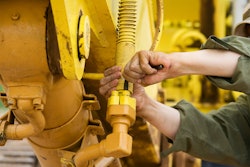
We asked the country’s top expert how to keep the interiors of your trucks and equipment as clean as possible to slow the spread of this virus.
While the cab of your truck or a piece of equipment might seem to be the perfect environment for social distancing, the fact is any of these enclosed spaces can harbor the coronavirus.
If somebody else jumps in your truck or excavator, even for just a minute, a second shift operator, a mechanic, fuel distributor, supervisor, or truck/delivery driver, that person could be carrying coronavirus and leave traces of it in the cab, on the door handle, grab bars, joysticks, arm rests, upholstery or monitor.
We asked Darren Priest, the country’s foremost expert on automotive detailing, what he would do to get the interiors of trucks and equipment as clean as possible and he’s got tons of good advice, techniques and products to share in the text and links below.
But keep these important caveats in mind:
- Cleanliness is next to godliness in the coronavirus age, but it is not a fool-proof cure or preventative. All it takes is one virus particle to get into your respiratory tract and you become infected. A single virus is no bigger than one micron. Getting rid of all of them in any environment is next to impossible. But super-cleaning your cabs will strip away a good bit of the residue on hard surfaces and upholstery that the virus clings to.
- Even though it is impossible to get rid of 100 percent of the virus, the more you get rid of, the better your chances of avoiding contamination. If you super clean the cab and knock out 98 percent of those viruses and you wear latex gloves for the duration of your shift, your chances of physical contact with the virus are greatly diminished. Not perfect, but we can’t let perfect be the enemy of good.
- None of the products in Priest’s website, or in this article make claims that they “kill” viruses. Soaps dissolved the grease or oil on your hands or the surfaces of your equipment. Viruses cling to these “sticky” surfaces and soaps and detergents break up the oils to which makes it easy for water to carry off the virus. Soaps also degrade the protective sheathing around most viruses, but they’re not 100 percent effective. Only bleach, alcohol, and things like Clorox wipes do that and those are destructive to interior surfaces.
Most important, you should realize that this is not going to be over any time soon. The virus may mutate and reemerge stronger than ever at any time until scientists come up with a vaccine. We’re in this for the long haul, at least another 18 months. If everybody will do their part we can greatly cut down on the transmission of this virus. But it will take extreme vigilance and in time, we hope, a vaccine or cure will be found.
Until then, if you’re going to be sharing a cab with any other people, here’s what you can do to keep it as clean and virus free as possible. Think of it as a daily routine, like checking the oil and coolant levels.
Hard surfaces
It is important to use cleaning products recommended for automotive interiors and not general household cleaners which may damage or discolor vinyl, plastics or leather. Be especially vigilant around monitors and touch screens as these typically have anti-glare coatings that can be damaged by harsh cleaners. Use a touch-screen compatible cleaner for these and check with your OEM dealer for recommendations.
For a go-to cleaner that can be mixed in different concentrations and used on most surfaces, Priest recommends Simple Green. It comes in small containers, gallons and by the barrel from industrial supply houses and is the most economical all-purpose cleaner for doing a volume of work.
“My rule is to start with product instructions and then tweak the dilution based on your needs,” says Priest. “As a rule, Simple Green is so safe, that even at full strength I am not afraid to use it on most materials except for the LCD or infotainment screens. My “go-to” dilution is 10:1. But 4:1 is a popular dilution ratio for me on excessively dirty areas.”
Another popular cleaner that’s usually benign is liquid dishwashing detergent like Dawn. But be careful to use it or any other cleaner in concentrations low enough to prevent damage, dulling or discoloration on finishes. Test it on an older machine or vehicle if you have concerns.
Priest recommends you start your cab cleaning by donning latex gloves and a dust mask. If you are accessing the cab from the ground, wipe down the door handle and grab bars with a suitable disinfectant wipe as you move into the cab. Clorox wipes are fine for these hard-metal surfaces.
If your truck or machine has floor mats, remove those and scrub them with a brush and cleaning solution. Rinse with a hose and let them air dry, preferably in the sun. Then use a shop vac or battery-powered vacuum to remove all dirt and debris from the interior of the cab before introducing liquid cleaners. Use a stiff brush to dislodge material from seams.
Next, you want to break your cab interior into sections so as concentrate your efforts and not get overwhelmed. Pick the dirtiest area or the area most likely to be contaminated. Spray the area and scrub to enhance the mechanical action of the cleaner. Finish by mopping up the area with a micro-fiber cloth. Priest says he prefers microfiber cloths because they are more absorbent, and the tight weave is far superior to any traditional cloth. If you don’t have any microfiber cloths any cloth is better than not cleaning your car’s interior, but you can get a stack of bundled microfiber cloths for about 80 cents each at auto supply stores or check out the links on Priest’s website.
Priest says you should normally wash micro-fibers in cold water, with no fabric softeners, but regular clothing soaps are fine. Dry on low heat. Bleach will change the color but should have no effect on their performance. High heat will make the ultra-fine fibers in these cloths dry and brittle, which will begin to shed or break off. This degrades their performance qualities when cleaning painted surfaces on the exterior of your car, truck or machine. But this should not be a problem for general interior cleaning.
Also clean your cab’s glass surfaces with your own cleaning solution or a dedicated glass cleaner but take care not to let overspray touch your monitor or LCD screens as these will degrade those. Let your surfaces dry, inspect, and repeat if necessary.
Upholstery
The hard surfaces are the places most likely to have been touched and harbor viruses, but you should also clean the upholstered surfaces like cloth seat covers, headliners and carpets if not daily or after every shift, then at least weekly.
At any auto parts store you can find a variety of upholstery cleaning products in spray cans and bottles. Or, again, you can mix up your own concentration of Simple Green and apply it with a spray bottle.
In addition to cleaning the obvious upholstery materials, pull out the seat belt and clean it along its entire length as well, including the buckle/latch mechanisms. The seat belt is one of the most frequently handled items in the cab.
In this video, Priest explains how to clean car seats, but many of the same general principles apply to machine cabs.
The typical process for upholstery cleaning is to wet the material, scrub it down and then extract the residue with a shop vac. But Priest takes it a step farther. He uses a professional steam cleaner that injects a hot blast of steam into the carpet and upholstery and immediately vacuums out the residue. This not only gives you much deeper and better cleaning, but many of these devices inject steam into the fabric that is hotter than 160 degrees Fahrenheit, which is enough to kill viruses.
As a professional detailer, Priest uses a $900 VX5000 machine. If you are a fleet manager with a lot of machines to clean the VX5000 may be worth investing in. But there are also plenty of consumer grade automotive upholstery cleaners for around $100 that do much the same thing and can be found at Lowes, Home Depot or Amazon. Links to these can be found on Priest’s website.
When you are done cleaning dispose of your microfiber cloths and/or scrub brushes in a bucket with a bleach solution in it and then wash in the washing machine. Where practical, let your brushes air dry in the sun. Dispose of any paper towels in in a trash bin, preferable a touchless trash bin like the ones found here.
To keep your cabs as virus free as possible, encourage all operators and drivers to wear latex gloves and face masks for the duration of their shift. Also have them wipe down the metal door handles and grab bars each time they enter and exit the cab with a disinfecting cleaner like Clorox wipes. Also wipe down the handles and latches to the battery box compartment and engine access points every time they’re used. If disinfecting wipes aren’t available (and they’re pretty hard to come by right now) use your own cleaner mix in a spray bottle that’s kept in the cab.
While upholstery cleaning may be too involved as a daily chore, you can certainly provide each machine with a spray bottle and diluted cleaning solution for wiping down the most obvious surfaces in the cab at every shift.
HVAC and air ducts
As anybody who has ever turned on the heat or AC in an older vehicle knows, these can collect quite a bit of mold or mildew, which by itself can be bad for your health. With the cab ventilation system running, one hard sneeze by an infected person could lodge thousands of viruses in the duct work.
To clean these, professional detailers like Priest will often use ozone machines. These create a form of oxygen that kills most types of bacteria, mold, mildew and viruses. To use them you put the ozone machine in the cab with the windows up, turn on the HVAC system and let ozone circulate in the air for the recommended period of time. There are dozens of medical studies that show ozone can kill the SARS Coronavirus and one report maintains that it could very well kill the current Covid-19 virus as well.
Even if your truck or machine is new and the HVAC smells as fresh as a spring day, it could not hurt to run an ozone machine inside the cabs as often as practical. Google “ozone machines for car detailing” and you’ll find an assortment for $300 to $700. Some people use air “bombs” that you set off inside a car or cab to freshen up the smell but there’s no evidence that these kill viruses and some of them may even anesthetize your nose to objectional smells and mask the odors of an underlying problem.
Priest says he hasn’t had the opportunity to test and evaluate ozone machines, but recommends that you do your research, read the online comments and buy what seems best for your purposes.

AutoFetishDetail.com
Best-Auto-Detailing-Tips.com
Also be sure to check out these application pages:
https://www.best-auto-detailing-tips.com/how-to-clean-car-interior.html
https://www.best-auto-detailing-tips.com/best-car-upholstery-cleaner.html











